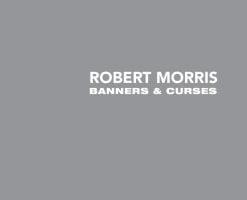Castelli Gallery, 24 W 40 St, is pleased to present Banners and Curses, an exhibition of new works by Robert Morris. The title of the show refers to the two featured series on display: Curses, which consists of eight fiberglass and epoxy objects, and Banners, a series of hanging synthetic fabric pieces. In both bodies of work, the artist produces a destabilizing synthesis of aesthetic form and political content by carefully manipulating the materials that link these two dimensions of meaning.
Robert Morris’s series of Curses consist of eight molded objects made of fiberglass cloth dipped in epoxy resin. While the resin is still wet, Morris shapes the fabric over a wooden box onto which he has molded politicized phrases and epithets in a clay-like material. The cloth eventually dries, retaining the form of the letters on the box as well as the pleats and billows of the draped fabric. In response to Morris’s Curses series art historian, Pepe Karmel, notes that “[t]he shimmering translucency and the lyric folds of the reliefs...belie the violence of the words semi-concealed within them. Impelling the viewer simultaneously toward rage and transcendence, they generate a kind of mental static: the hiss, pop, and crackle of severe cognitive dissonance.”
In addition, Robert Morris’s use of fiberglass material in his Curses connect this series with his early minimal work. Starting in the late 1960s, Morris remade several of his geometric plywood constructions in fiberglass, both because the translucency of fiberglass gave them a unique ethereal quality. These works likewise recall Morris’s earlier series MOLTINGSEXOSKELETONSSHROUDS (2015) and Boustrophedons (2017) in which he similarly uses epoxy-saturated fabric to create three-dimensional figures that nonetheless retain the supple appearance of cloth.
The second group of works—Banners—include eight 7 by 10 1⁄2 foot synthetic canvases, UV printed with a montage of images evoking subjects ranging from Francisco Goya’s Los Caprichos prints, to the films of Stanley Kubrick, to contemporary politics. In these pieces Robert Morris draws on two main visual references. The first are cartoons. In an essay he wrote in 2017 titled “Toward the Cartoon” the artist indicates his interest in the strategies cartoons use to convey meaning: “There is something about the inversion of the cartoon that plays on the dualistic when the awe of beauty can be tilted into laughter, and terror and threat can be upended with a clown countenance.”
In his Banners, Morris calls forth the cartoon’s capacity to break down dichotomies through his use of a visual vocabulary that elides the farcical with the terrifying, the intimate with the public, beauty with the grotesque. A second act of elision occurs on the level of the works’ form: the large scale of the canvases contrasts with the typical dimensions of cartoons, which commonly circulate through print media such as books and periodicals—objects that can be held in the hand. The mural-size of these works reference the banners frequently used as advertisement outside of buildings, for example those hung on the facades of museums to promote exhibitions. This enlarging of a genre traditionally considered an inferior artform to the monumental scale of a Neoclassical history painting compounds the cartoon’s subversive tendency by undermining conventional notions of “correct” proportion. In a final ironic turn, the viewer realizes that this humorous vision of the world blown out of proportion, in fact all too accurately represents our current socio-political reality.
For more information, please contact Broc Blegen at broc@castelligallery.com














